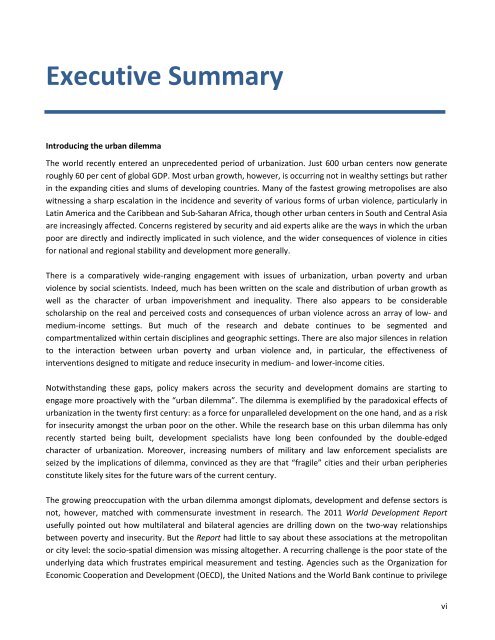Researching-the-Urban-Dilemma-Baseline-study
Researching-the-Urban-Dilemma-Baseline-study
Researching-the-Urban-Dilemma-Baseline-study
You also want an ePaper? Increase the reach of your titles
YUMPU automatically turns print PDFs into web optimized ePapers that Google loves.
Executive Summary<br />
Introducing <strong>the</strong> urban dilemma<br />
The world recently entered an unprecedented period of urbanization. Just 600 urban centers now generate<br />
roughly 60 per cent of global GDP. Most urban growth, however, is occurring not in wealthy settings but ra<strong>the</strong>r<br />
in <strong>the</strong> expanding cities and slums of developing countries. Many of <strong>the</strong> fastest growing metropolises are also<br />
witnessing a sharp escalation in <strong>the</strong> incidence and severity of various forms of urban violence, particularly in<br />
Latin America and <strong>the</strong> Caribbean and Sub-Saharan Africa, though o<strong>the</strong>r urban centers in South and Central Asia<br />
are increasingly affected. Concerns registered by security and aid experts alike are <strong>the</strong> ways in which <strong>the</strong> urban<br />
poor are directly and indirectly implicated in such violence, and <strong>the</strong> wider consequences of violence in cities<br />
for national and regional stability and development more generally.<br />
There is a comparatively wide-ranging engagement with issues of urbanization, urban poverty and urban<br />
violence by social scientists. Indeed, much has been written on <strong>the</strong> scale and distribution of urban growth as<br />
well as <strong>the</strong> character of urban impoverishment and inequality. There also appears to be considerable<br />
scholarship on <strong>the</strong> real and perceived costs and consequences of urban violence across an array of low- and<br />
medium-income settings. But much of <strong>the</strong> research and debate continues to be segmented and<br />
compartmentalized within certain disciplines and geographic settings. There are also major silences in relation<br />
to <strong>the</strong> interaction between urban poverty and urban violence and, in particular, <strong>the</strong> effectiveness of<br />
interventions designed to mitigate and reduce insecurity in medium- and lower-income cities.<br />
Notwithstanding <strong>the</strong>se gaps, policy makers across <strong>the</strong> security and development domains are starting to<br />
engage more proactively with <strong>the</strong> “urban dilemma”. The dilemma is exemplified by <strong>the</strong> paradoxical effects of<br />
urbanization in <strong>the</strong> twenty first century: as a force for unparalleled development on <strong>the</strong> one hand, and as a risk<br />
for insecurity amongst <strong>the</strong> urban poor on <strong>the</strong> o<strong>the</strong>r. While <strong>the</strong> research base on this urban dilemma has only<br />
recently started being built, development specialists have long been confounded by <strong>the</strong> double-edged<br />
character of urbanization. Moreover, increasing numbers of military and law enforcement specialists are<br />
seized by <strong>the</strong> implications of dilemma, convinced as <strong>the</strong>y are that “fragile” cities and <strong>the</strong>ir urban peripheries<br />
constitute likely sites for <strong>the</strong> future wars of <strong>the</strong> current century.<br />
The growing preoccupation with <strong>the</strong> urban dilemma amongst diplomats, development and defense sectors is<br />
not, however, matched with commensurate investment in research. The 2011 World Development Report<br />
usefully pointed out how multilateral and bilateral agencies are drilling down on <strong>the</strong> two-way relationships<br />
between poverty and insecurity. But <strong>the</strong> Report had little to say about <strong>the</strong>se associations at <strong>the</strong> metropolitan<br />
or city level: <strong>the</strong> socio-spatial dimension was missing altoge<strong>the</strong>r. A recurring challenge is <strong>the</strong> poor state of <strong>the</strong><br />
underlying data which frustrates empirical measurement and testing. Agencies such as <strong>the</strong> Organization for<br />
Economic Cooperation and Development (OECD), <strong>the</strong> United Nations and <strong>the</strong> World Bank continue to privilege<br />
vi




